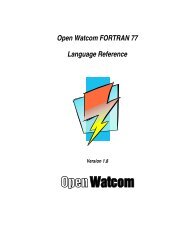ELF-64 Object File Format - Open Watcom
ELF-64 Object File Format - Open Watcom
ELF-64 Object File Format - Open Watcom
Create successful ePaper yourself
Turn your PDF publications into a flip-book with our unique Google optimized e-Paper software.
• e_ident[EI_CLASS] identifies the class of the object file, or its capacity.<br />
Table 3 lists the possible values.<br />
This document describes the structures for <strong>ELF</strong>CLASS<strong>64</strong>.<br />
The class of the <strong>ELF</strong> file is independent of the data model assumed by the<br />
object code. The EI_CLASS field identifies the file format; a processorspecific<br />
flag in the e_flags field, described below, may be used to identify<br />
the application’s data model if the processory supports multiple models.<br />
• e_ident[EI_DATA] specifies the data encoding of the object file data<br />
structures. Table 4 lists the encodings defined for <strong>ELF</strong>-<strong>64</strong>.<br />
For the convenience of code that examines <strong>ELF</strong> object files at run time<br />
(e.g., the dynamic loader), it is intended that the data encoding of the<br />
object file will match that of the running program. For environments that<br />
support both byte orders, a processor-specific flag in the e_flags field,<br />
described below, may be used to identify the application’s operating mode.<br />
• e_ident[EI_VERSION] identifies the version of the object file format.<br />
Currently, this field has the value EV_CURRENT, which is defined with the<br />
value 1.<br />
• e_ident[EI_OSABI] identifies the operating system and ABI for which the<br />
object is prepared. Some fields in other <strong>ELF</strong> structures have flags and<br />
values that have environment-specific meanings; the interpretation of<br />
those fields is determined by the value of this field. Table 5 lists the<br />
currently-defined values for this field.<br />
• e_ident[EI_ABIVERSION] identifies the version of the ABI for which the object<br />
is prepared. This field is used to distinguish among incompatible versions<br />
of an ABI. The interpretation of this version number is dependent on the<br />
ABI identified by the EI_OSABI field.<br />
For applications conforming to the System V ABI, third edition, this field<br />
should contain 0.<br />
• e_type identifies the object file type. The processor-independent values<br />
for this field are listed in Table 6.<br />
• e_machine identifies the target architecture. These values are defined in<br />
the processor-specific supplements.<br />
• e_version identifies the version of the object file format. Currently, this<br />
field has the value EV_CURRENT, which is defined with the value 1.<br />
• e_entry contains the virtual address of the program entry point. If there is<br />
no entry point, this field contains zero.<br />
• e_phoff contains the file offset, in bytes, of the program header table.<br />
• e_shoff contains the file offset, in bytes, of the section header table.<br />
• e_flags contains processor-specific flags.<br />
• e_ehsize contains the size, in bytes, of the <strong>ELF</strong> header.<br />
• e_phentsize contains the size, in bytes, of a program header table entry.<br />
• e_phnum contains the number of entries in the program header table.<br />
• e_shentsize contains the size, in bytes, of a section header table entry.<br />
• e_shnum contains the number of entries in the section header table.<br />
4 <strong>ELF</strong>-<strong>64</strong> <strong>Object</strong> <strong>File</strong> <strong>Format</strong>, Version 1.5 Draft 2
















